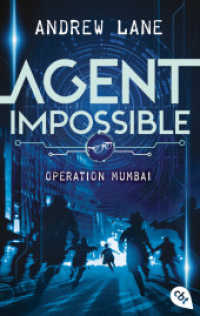Full Description
A brand new and fully updated edition of this seminal work on archival preservation. Access to archival material - the documentary heritage of people all over the world that gives them their identity and ensures their rights - is dependent on the survival of fragile materials: paper, parchment, photographic materials, audiovisual materials and, most recently, magnetic, optical and increasingly digital formats. The primary importance of such survival is widely acknowledged but sometimes overlooked in a rush to provide ever better means of access. But without the basic material, no services can be offered. Preservation is at the heart of archival activity. Archivists in all types of organizations face questions on how to plan a preservation strategy in less than perfect circumstances, or deal with a sudden emergency. This book considers the causes of threats to the basic material, outlines the preservation options available and offers flexible solutions applicable in a variety of situations. It offers a wide range of case studies and examples from international specialists. This revised edition includes additional material on digital preservation and green building as well as a new chapter on the management and training of volunteers, reflecting a key concern for many archival institutions. Key topics are: • Understanding archival materials and their characteristics • Managing digital preservation • Archive buildings and their characteristics • Safeguarding the building and its contents • Managing archival storage • Managing risks and avoiding disaster • Creating and using surrogates • Exhibiting archives • Handling the records • Managing a pest control programme • Training and the use of volunteers • Putting preservation into practice. Readership: Archivists, librarians, curators and enthusiasts, trained and untrained, in museums, local studies centres and voluntary societies in need of good clear advice.
Contents
Introduction to the series - Geoffrey Yeo
1. Introducing archive preservation
Introduction
How has the relationship between conservation and preservation developed?
Definitions
Summary
Notes
2. Understanding archival materials and their characteristics
Introduction
Paper
Parchment
Inks: from carbon ink to laser printing
Photographic materials
Analogue audiovisual materials: wax cylinders, shellac and vinyl discs and film
Optical materials: CDs and DVDs
Magnetic materials: tape, hard disks and floppy disks
Minidiscs
Portable digital storage
Summary
Notes and references
3. Managing digital preservation
Introduction
Why is digital preservation management important?
Why is digital preservation difficult?
Costs of digital preservation
What should be preserved?
Who should be involved?
What is the starting point?
What happens next?
Summary
Notes and references
4. Archive buildings and their characteristics
Introduction
How has the concept of archive buildings developed?
How did archive buildings develop in the UK?
What other ideas have developed for archive buildings?
What should be considered before building or adapting an existing building to house an archive?
What needs to be explained?
Location
How should the architect be briefed?
What are the problems with adapted buildings or historic buildings?
Summary
Notes and references
5. Safeguarding the building and its contents
Introduction
Security
Fire prevention, detection and suppression
Water detection
Environmental issues
Summary
Notes and references
6. Managing archival storage
Introduction
Why do environmental conditions matter?
What needs to be controlled?
Mould: why is it such a threat?
Measuring and monitoring temperature and humidity
Measuring and monitoring pollution levels
Special arrangements
How can comparative costs be assessed?
Shelving, racking and plan chest specifications
What kind of equipment is needed?
Possible future developments
Summary
Notes and references
7. Managing risks and avoiding disaster
Introduction
Why undertake an 'operation-hope-not'?
Definitions
Who is responsible for disaster planning?
What should be saved first?
Development of a disaster control plan: where to start?
Prevention
Preparation
Reaction
Recovery
Evaluation
Summary
Notes and references
8. Creating and using surrogates
Introduction
Copying archive material
What copying techniques are available?
What problems arise?
Developing a preservation copying policy: why do it?
How can the copies themselves be preserved?
Selecting correct copying methods
Preparation of material
Copying of material in-house
Use of outside agencies
Summary
Notes and references
9. Moving the records
Introduction
What are the risks?
Planning the project
Briefing a suitable removal firm
Minimum removal equipment specifications
Preparing for the move
The move itself
And afterwards...
Summary
Notes and references
10. Exhibiting archives
Introduction
How can the overall risk be minimized?
Managing the care of documents in exhibitions
Planning and preparing for an exhibition
During the exhibition
And afterwards...
Summary
Notes and references
11. Handling the records
Introduction
The problem
Improving the quality of care: how can it be achieved?
Where and how can good practice be demonstrated to readers?
How can staff be best trained?
Summary
Notes
12. Managing a pest control programme
Introduction
What are the common pests?
What damage do pests do to archival materials?
Where are they likely to be active?
What are the signs of an infestation?
How can they be prevented from getting into the collections?
Why are previous eradication measures no longer used?
Why is integrated pest management (IPM) now adopted as a strategy?
How can IPM be introduced?
Setting traps
Dealing with an infestation
Ongoing management
Summary
Notes and references
13. Training and the use of volunteers
Introduction
What options for preservation training are available?
What areas of preservation should be covered?
The use of volunteers
What are the key challenges of using volunteers?
Using volunteers for preservation activities
The importance of documentation
Volunteers and the interface with conservation
Summary
Notes and references
14. Putting preservation into practice
Introduction
Choices and options
Who is responsible?
What is a preservation policy?
What about strategies?
Costs, funding and options
How is a programme planned and put into action?
And the results?
Notes and references
Appendices
The National Archives Conditions for Loans policy
A conservation workshop
Compiling a Preservation Policy; an advisory template
UCL Library Services: Volunteer Agreement
Benchmarking entries: MLA
Bibliography
British and international standards relating to archive preservation






